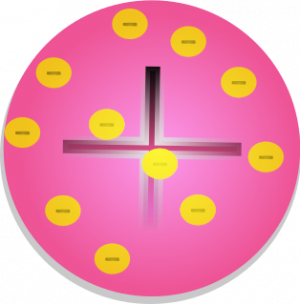Table of Contents
Section 10.7 and 10.8 in Matter and Interactions (4th edition)
Discovery of the Nucleus
There is a long history about what makes up matter starting with Democritus in Ancient Greece and continuing through modern times. A critical experiment that spurred many future experiments was Rutherford's discovery of the nucleus in 1911. This experiment used a simple collision between Helium nuclei and gold foil and demonstrated the existence of the nucleus.
Plum Pudding Model of the Atom
Prior to this experiment, the leading theory of what made up atoms is credited to J.J. Thomson. Previous experiments discovered the existence and some of the properties of the electron, but we unable to resolve details of the atom itself. Thomson suggested that matter was like a plum pudding where the negative electron “raisins” were suspended in a pudding-like positively charged, low density “pudding”.
Ernst Rutherford hypothesized that if he could send charged particles into some form of matter that the small deflections due to the interactions with the negatively charged electrons would confirm his atomic theory. That is, Rutherford and his team went out to validate the model of atoms that were informed by their (and others') previous experiments and the leading models of the day.
The Rutherford Experiment
Rutherford and his team were aided in their work by the recent discovery by Henri Becquerel, Marie Curie, and Pierre Curie. They had found that a particular radioactive source ejected high speed positively charged particles, which they called “alpha particles.” These particles are what we know to be Helium nuclei now.
Using a source of these particles, Rutherford and his team collimated the source to send the alpha particles at a thin gold foil target. They set up detectors to measure the deflections of the alpha particles. Most of the alpha particles they sent through the gold foil passed through with little deflection (as they had expected). However, a few of them returned back at them. That is, some of the alpha particles “bounced” off something in the gold foil and came straight back!
In Rutherford's words, “It was quite the most incredible event that has ever happened to me in my life. It was almost as incredible as if you fired a 15-inch [artillery] shell at a piece of tissue paper and it came back and hit you.”
This new evidence suggested that the positive charge in matter was concentrated at a single point, what we now understand to be the nucleus containing positive protons and neutral neutrons.
